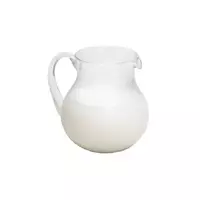Cream

Cream belongs to no less popular dairy products than milk, cottage cheese, kefir or sour cream. By the way, in industrial production, along with home conditions, butter and sour cream of various fatness, as well as a variety of culinary products, are made from them. Cream is included in the recipes of numerous sauces, some mashed soups, sweet dishes and, of course, confectionery (ice cream, creams and cocktails). Often they are added to various hot drinks, such as coffee or tea.
White or yellowish cream has a sweet, but not cloying taste, with a taste of pasteurization. The gastronomic and beneficial properties of cream depend on the quality and fat content. So, for example, in good cream there should be no fatty lumps or protein flakes - such a product should have a uniform consistency. High-quality cream cannot be moldy or bitter, as well as have other flavors that are not characteristic of this dairy product.
Today, the assortment of Russian stores can offer several options for this dairy product, the varieties of which depend on the fat content and method of processing. Thus, according to the latest indicator, dairy cream is divided into pasteurized and sterilized. The pasteurized product can be stored for about 3 days, while the shelf life of the sterilized cream is 4 months. According to the percentage of fat on which the calorie content of cream depends and the direct use of this product for culinary purposes, the following go on sale:
cream 8% fat;
cream of 10% fat content;
20% fat cream;
25% fat cream;
cream 33% fat;
cream 35% fat.
The modern food industry can also offer an alternative to a natural dairy product - the so-called "vegetable cream, " which is made based on vegetable fats. In addition to this ingredient, milk proteins are present in the composition of such cream, which provide the product with the aroma and taste of natural milk cream, as well as dyes, stabilizers, acidity regulators emulsifiers and flavors.
Cream composition
The main biological value of this product lies in the composition of cream, which includes a large amount of phosphatides. In their structure, these substances have much in common with fats, but differ in the presence of phosphoric acid and nitrogenous base.
The composition of cream is very close to the composition of milk, differing only in a high fat content, in connection with which we can say that cream is milk with a fat content of at least 8 percent. As for nutritional value, that is, the percentage of carbohydrates, proteins and fats, here cream also does not have much advantages over cow's milk.
The benefits of cream
It has been proven that foods with a high fat content are poorly absorbed by the body, but this fact does not apply to our product. The benefits of cream and products based on them are indispensable with sharp weight losses, as well as exhaustion. Omega-3 acid, which is in their composition, is very useful for people who are active mentally. Cream is recommended to be included in the diet of people suffering from gastritis, as well as peptic ulcer of the duodenum and stomach.
In addition, the benefits of cream are also indicated by the ability to calm the nervous system, having a favorable effect in depression. In its pure form, this milk product helps with edema, and also acts as a cosmetic rejuvenating agent.
Harm of cream
Like most fatty foods, not all people are recommended to eat cream. Thus, the possible harm of cream can affect patients suffering from obesity, atherosclerosis and liver diseases. They should not be offered to children under the age of two. And with intolerance to milk proteins, this product is completely contraindicated.
cream 206 kCal
The energy value of cream (Ratio of proteins, fats, carbohydrates - ju):
Proteins: 2.5 g (~ 10 kCal)
Fats: 20 g (~ 180 kCal)
Carbohydrates: 3.4 g (~ 14 kCal)
Energy ratio (bj | y): 5% | 87% | 7%
 Español
Español Français
Français Português
Português Русский
Русский 简体中文
简体中文 繁體中文
繁體中文 日本語
日本語 한국어
한국어 العربية
العربية Türkçe
Türkçe Қазақ
Қазақ Deutsch
Deutsch Italiano
Italiano Українська
Українська
